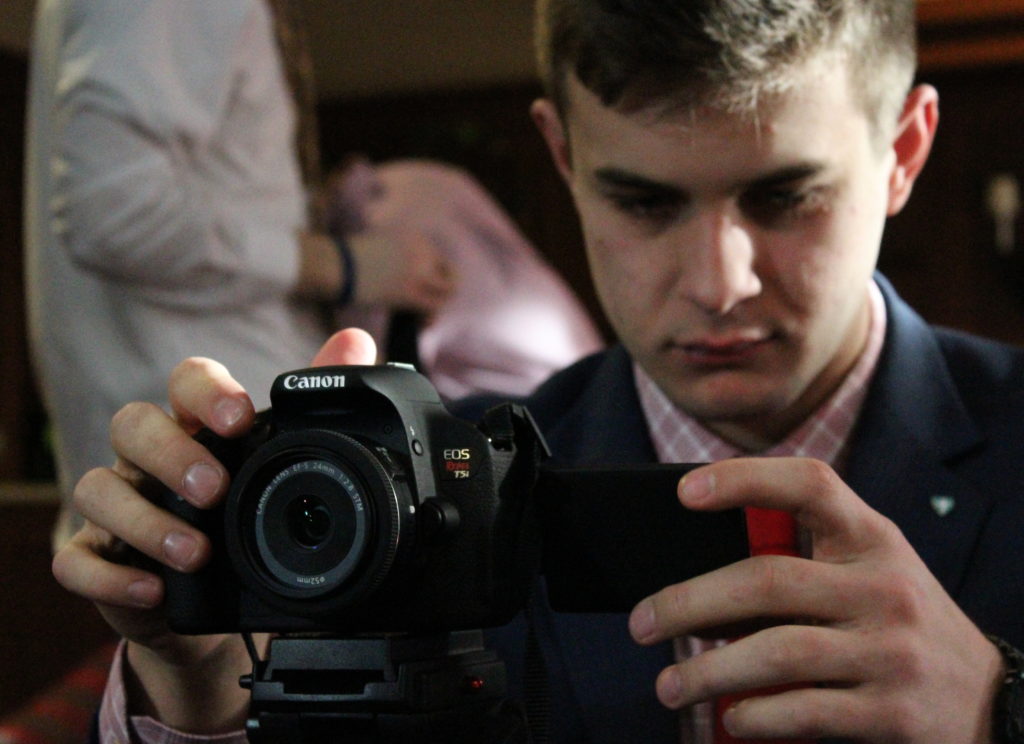
The fall of my sophomore year, Jordan Finney ’16 and I rushed to the Grewcock Student Union after our Monday classes to set up a camera and boom-microphone in the Richard Raese Conference Room. We were scheduled to film an interview with visiting professor of history Victor Davis Hanson, and the conference room was the only available filming space.
A long and narrow conference-room table dominates the relatively small room, which isn’t optimal for filming, but it was the only room without other students.
Situations like this one are fairly common for student journalists trying to film interviews, and because Hillsdale doesn’t have a student TV studio, student journalists looking to film shows and interviews often have to be creative about finding a suitable filming location.
The college is already raising money for a Film and Documentary Program, which would train students in documentary filmmaking and digital media. Not included in this budget, however, is funding for a studio — a vital part of video production that would also round out the college’s Dow Journalism Program. A TV studio does exist on campus in the basement of the Old Student Union, but it’s not for student use. The college uses it to film videos or facilitate interviews with broadcast television stations like Fox News.
Hillsdale already has multiple well-established student print publications and a blossoming radio program. A TV studio would make these offerings more complete. By opening a small TV studio just for students, the college would provide another tool to prepare them for careers in journalism, videography, theater, and rhetoric.
Hillsdale’s journalism program values hands-on experience over theories taught in the classroom, and a student TV studio would enhance this learning experience by allowing students to imagine ways to use this classroom knowledge to translate their video ideas into reality.
Today’s print journalists, at print publications of all sizes, need to use video in their reporting. New York Times reporters frequently share their findings on Facebook Live, and the mid-sized Detroit News recently began filming short videos with columnists to talk about recent political events or upcoming sports match-ups.
Students already use classroom teachings to inform their writing, and since last year, their on-air radio commentaries. It would be beneficial for students to have the opportunity to learn how to do this in front of a camera.
Even without a TV studio currently available to students, senior Kayla Stetzel and sophomore Jordyn Pair began a film and production club in February, and this semester, members of The Collegian film a weekly interview show.
In the first full year of the Radio Free Hillsdale, over 10 student-produced radio shows and segments have been launched. This could easily happen with a TV studio as well. Students could create news shows, sports-talk shows, interview shows, comedy routines, or even video essays. These videos could then be shown live or saved for later on Facebook or YouTube at no cost.
While alumni like Genna Hilgenbrink ’15, Abigail Gilbert ’14, and Kat Timpf ’10, were able to make the jump from print to TV without the benefit of a studio to practice in, it doesn’t mean future students wouldn’t benefit from on-campus broadcast experience.
Money has already been set aside to hire a staff member to run the Film and Documentary program. In making the final hiring decision, the college could choose someone capable of running a student journalist TV studio as well, like Scot Bertram does with the radio station.
For as little as $200,000 extra, in addition to the $740,000 earmarked for equipment, the college could pay for the construction of a TV studio. While the college’s current studio cost about $1.7 million to construct, a student equivalent could be built much less expensively because it would only need to produce internet-quality videos. It wouldn’t need to meet the broadcast-quality standards the college’s TV studio currently has to meet to host professor interviews on Fox News. The cost difference between high-end consumer equipment and broadcast-quality equipment is substantial.
And while space to build a studio up the hill is extremely limited, the college could potentially convert a floor of one of the college-owned houses currently being rented-out into studio space.
Today’s journalists must be well-versed in video as well as print and radio. Hillsdale College should consider directing some of the money it raises in the Film and Documentary Program campaign toward building a TV studio, where motivated students could develop their skills for video while putting their rhetorical and writing skills into practice.

